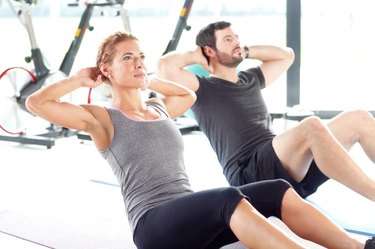
Correct breathing techniques when you're doing stomach exercises — or being physically active in general — can make a huge difference in the outcome of your workout. Breathing correctly means your workout can leave you feeling energized, while improper breathing can leave you feeling fatigued. It might even result in injury or other health problems, such as headaches, dizziness and pain in the neck and shoulders. Therefore, it's important to bring mindfulness into your breathing when you're doing stomach exercises.
Getting It Right
Video of the Day
First, the basics: "The golden rule for breathing when you're working out is to exhale during the hard part and inhale during the easy part," says Los Angeles-based personal trainer David Knox, author of "Body School: A New Guide to Improved Movement in Daily Life." "This is especially true when you're doing abdominal exercises like crunches, planks or sit-ups."
Video of the Day
- For sit-ups and crunches, exhale when you're lifting your torso and inhale when you're lowering it back to the ground.
- For leg lifts, exhale when you're lifting your legs and inhale when you're lowering them.
- For planks, inhale when you're lowering and exhale when you're lifting. Maintain a regular breathing rhythm when you're holding the pose.
The chest should fill up laterally rather than from front to back, "Like the sail of a Spanish galleon filling out from the sides," says Knox. "Your ribcage and core shouldn't thrust forward, but should expand outward. You should feel a sense of expansion through the rib cage and the middle of the back."
Tip
As you exhale, squeeze from below the navel. As you inhale, let the air rush upward into your chest and feel your ribcage expand and open. Additionally, don’t hold your breath, as it causes blood pressure to rise and muscle to contract.
Read More: Breathing Exercises to Increase Oxygen Rate
Breathing Exercises for the Abs
In fact, breathing exercises by themselves can strengthen your abdominal muscles, says Knox, who's also a yoga instructor. Applying force to the breath when both inhaling and exhaling can strengthen the belly. When exhaling air, the body relies on abdominal muscles to squeeze force air out of the thoracic cavity.
Normally, breath is drawn in and out by the abdominal muscles. During exercise or intentional forced breathing, the secondary breathing muscles in the chest engage. This lifts the ribs, allowing the lungs more room to inflate as more air rushes in.
For a simple ab-strengthening breathing exercise, lie flat on your back and gradually lengthen the duration of your inhalations and exhalations. "The more you control your breathing muscles in your workout, the stronger and more articulate they're going to become," says Knox.
Read More: 10 Most Effective Ab Workouts